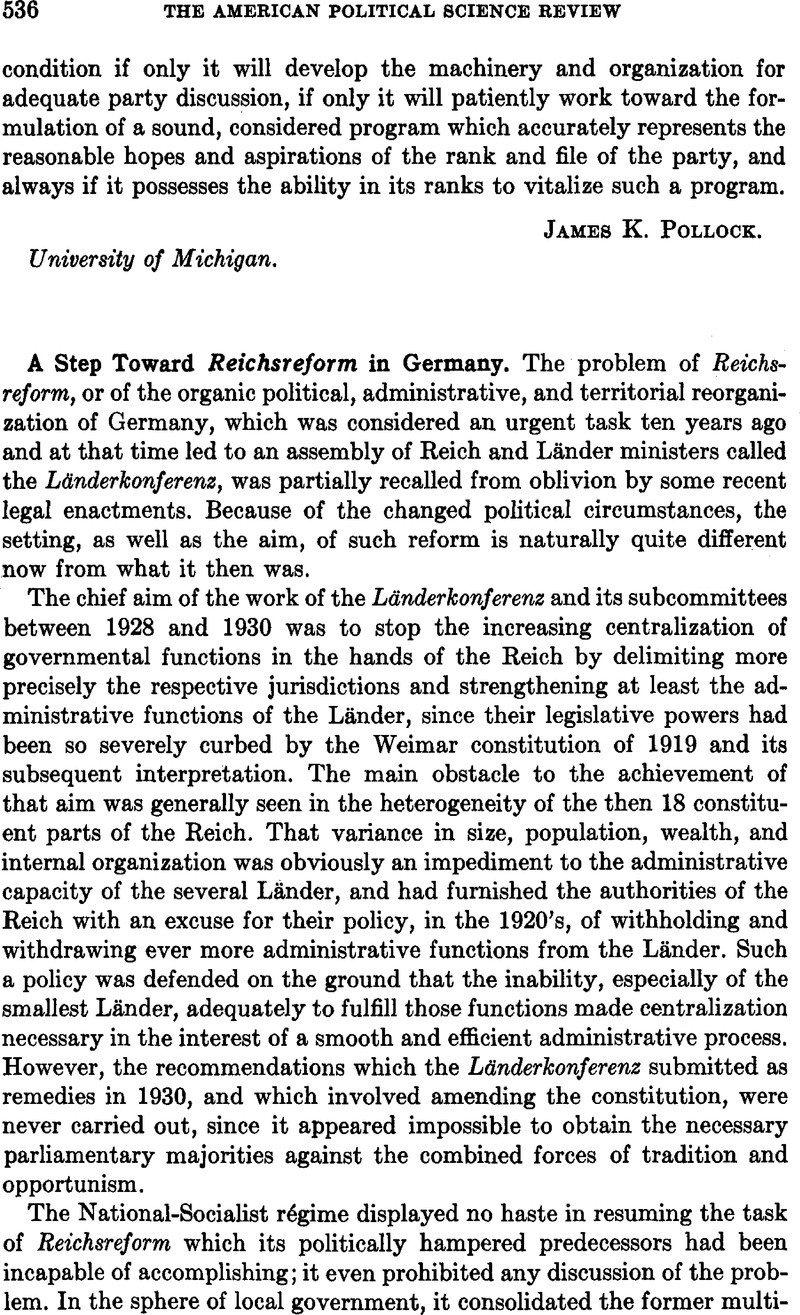No CrossRef data available.
Article contents
A Step Toward Reichsreform in Germany
Published online by Cambridge University Press: 02 September 2013
Abstract

- Type
- Foreign Government and Politics
- Information
- Copyright
- Copyright © American Political Science Association 1938
References
1 Dated January 30, 1935. RGBl (Reichsgesetzblatt), Pt. I, p. 49. For an analysis of the Municipal Code, see article by Roger H. Wells in the August, 1935, issue of this Review.
2 By law of January 30, 1934 (RGBl., I, p. 75Google Scholar).
3 By laws of April 7, 1933 (RGBl., I, p. 173Google Scholar) and January 30, 1935 (RGBl., I, p. 65Google Scholar).
4 The total population of the state was 1,200,000, of which 1,110,000 lived in the city itself, while the remaining 90,000 was divided among three towns and 23 rural communities. The city covered one-third of the state's total area of 415 sq. km. Cf. Horkenbach, Cuno, Handbuch der Reichs- und Staatsbehörden, 1935–1936, p. 106Google Scholar.
5 RGBl., I, p. 91Google Scholar. The same statute also decreed the merger of Lubeck in Prussia and the exchange of territory between Prussia and Oldenburg and between Prussia and Mecklenburg.
6 RGBl., I, p. 1327Google Scholar.
7 The statute calls it an “Einheitsgemeinde.” It is to incorporate all those 50—formerly municipally independent—small communities, together with Hamburg proper, into one municipal body under one central municipal administration.
8 Völkischer Beobachter (Süddeutsche Ausgabe), December 10, 1937.
9 “State” is here used as distinguished from “municipal.” With Germany now a unitary state, the terms “federal” and “state” cannot any longer be used as referring to the Reich and the Länder, respectively. However, a great deal of the old official terminology, reminiscent of the former status of the Länder, still prevails. Cf. Becker, Erich, “Die Rechtsstellung der deutschen Länder in der Gegenwart,” Zeitschrift für die gesamte Staatswissenschaft, 97 (1937), pp. 462–498Google Scholar.
10 Even if the mayor were highest, it would make little practical difference so long as both he and the governor owed their appointment to the same central Reich authorities.
11 In Art. 6, the law on governors, of January 30, 1935, still spoke of legislation of the former Lander.
12 RGBl., I, p. 1214Google Scholar.
13 The wording of the statute is not clear on this point.
14 The Ratsherren, supposedly replacing the former municipal legislature, are to represent the various interests among the citizenry.
15 Ordinance of March 26, 1935 (RGBl., I, p. 470Google Scholar).





Comments
No Comments have been published for this article.